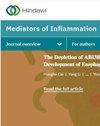隐丹参酮通过抑制 NLRP3 抑制脂多糖诱导的炎症微环境中膀胱癌细胞的恶性进展
IF 4.4
3区 医学
Q2 CELL BIOLOGY
引用次数: 0
摘要
背景:膀胱癌(BC)是泌尿生殖系统最常见的恶性肿瘤之一。膀胱癌(BC)是泌尿生殖系统最常见的恶性肿瘤之一。本研究评估了膀胱癌中的核苷酸结合寡聚结构域和富亮氨酸重复及含吡啶结构域蛋白3(NLRP3),以及隐丹参酮在脂多糖(LPS)诱导的炎症微环境下对膀胱癌恶性行为和NLRP3表达变化的影响。研究方法收集62例患者的BC组织标本,对NLRP3蛋白进行免疫组化检测。培养 BC 和正常尿路细胞系,检测 NLRP3 mRNA 和蛋白。然后,用 LPS 预处理 BC 细胞,以模拟炎症性肿瘤微环境。然后,用低剂量或高剂量隐丹参酮培养这些细胞,以评估其对肿瘤细胞恶性行为的影响,并转染 NLRP3 cDNA 以证实 NLRP3 在体外 BC 细胞中的作用。结果显示NLRP3的高表达与肿瘤直径增大(2厘米)、肌肉侵袭和转移有关。在 BC 细胞中,NLRP3 mRNA 和蛋白水平高于正常尿路细胞。LPS 能明显促进 BC 细胞中 NLRP3 和炎性细胞因子的表达,并诱导细胞活力、迁移和侵袭。然而,隐丹参酮能够降低 LPS 诱导的 NLRP3 和炎性细胞因子表达的增加以及 BC 细胞的恶性发展。使用 NLRP3 cDNA 过表达 NLRP3 会进一步促进 LPS 刺激后 BC 细胞的恶性进展,并逆转隐丹参酮降低的 LPS 诱导的 BC 细胞恶性行为。结论NLRP3 在 BC 中可能具有致癌活性,而隐丹参酮在 BC 体外的抗肿瘤活性可能与其抑制 NLRP3 表达有关。本文章由计算机程序翻译,如有差异,请以英文原文为准。
Cryptotanshinone Inhibits Bladder Cancer Cell Malignant Progression in a Lipopolysaccharide-Induced Inflammatory Microenvironment through NLRP3 Inhibition
Background. Bladder cancer (BC) is one of the most common malignancies of the urogenital system. This study assessed the nucleotide-binding oligomerization domain and leucine-rich repeat and pyrin domain-containing protein 3 (NLRP3) in BC as well as the effects of cryptotanshinone on changes in BC malignant behaviors and NLRP3 expression under a lipopolysaccharide (LPS)-induced inflammatory microenvironment. Methods. BC tissue specimens from 62 patients were collected for immunohistochemical detection of NLRP3 protein. BC and normal urothelial cell lines were cultured for the detection of NLRP3 mRNA and protein. Then, BC cells were pretreated with LPS to mimic the inflammatory tumor microenvironment. Next, these cells were incubated with a low or high dose of cryptotanshinone to assess its effects on tumor cell malignant behaviors as well as transfected with NLRP3 cDNA to confirm the role of NLRP3 in BC cells in vitro. Results. High NLRP3 expression was associated with larger tumor diameters (>2 cm), muscle invasion, and metastasis. The levels of NLRP3 mRNA and protein were greater in BC cells than in normal urothelial cells. LPS pretreatment significantly promoted NLRP3 and inflammatory cytokine expression in BC cells, and induced cell viability, migration, and invasion. However, cryptotanshinone was able to reduce the LPS-induced increase of NLRP3 and inflammatory cytokine expression as well as the BC cell malignant progression. NLRP3 overexpression using NLRP3 cDNA further promoted BC cell malignant progression after LPS stimulation and reversed cryptotanshinone-reduced LPS-induced BC cell malignant behaviors. Conclusion. NLRP3 might possess oncogenic activity in BC, and the antitumor activity of cryptotanshinone in BC in vitro might be related to its inhibition of NLRP3 expression.
求助全文
通过发布文献求助,成功后即可免费获取论文全文。
去求助
来源期刊

Mediators of Inflammation
医学-免疫学
CiteScore
8.70
自引率
0.00%
发文量
202
审稿时长
4 months
期刊介绍:
Mediators of Inflammation is a peer-reviewed, Open Access journal that publishes original research and review articles on all types of inflammatory mediators, including cytokines, histamine, bradykinin, prostaglandins, leukotrienes, PAF, biological response modifiers and the family of cell adhesion-promoting molecules.
 求助内容:
求助内容: 应助结果提醒方式:
应助结果提醒方式:


